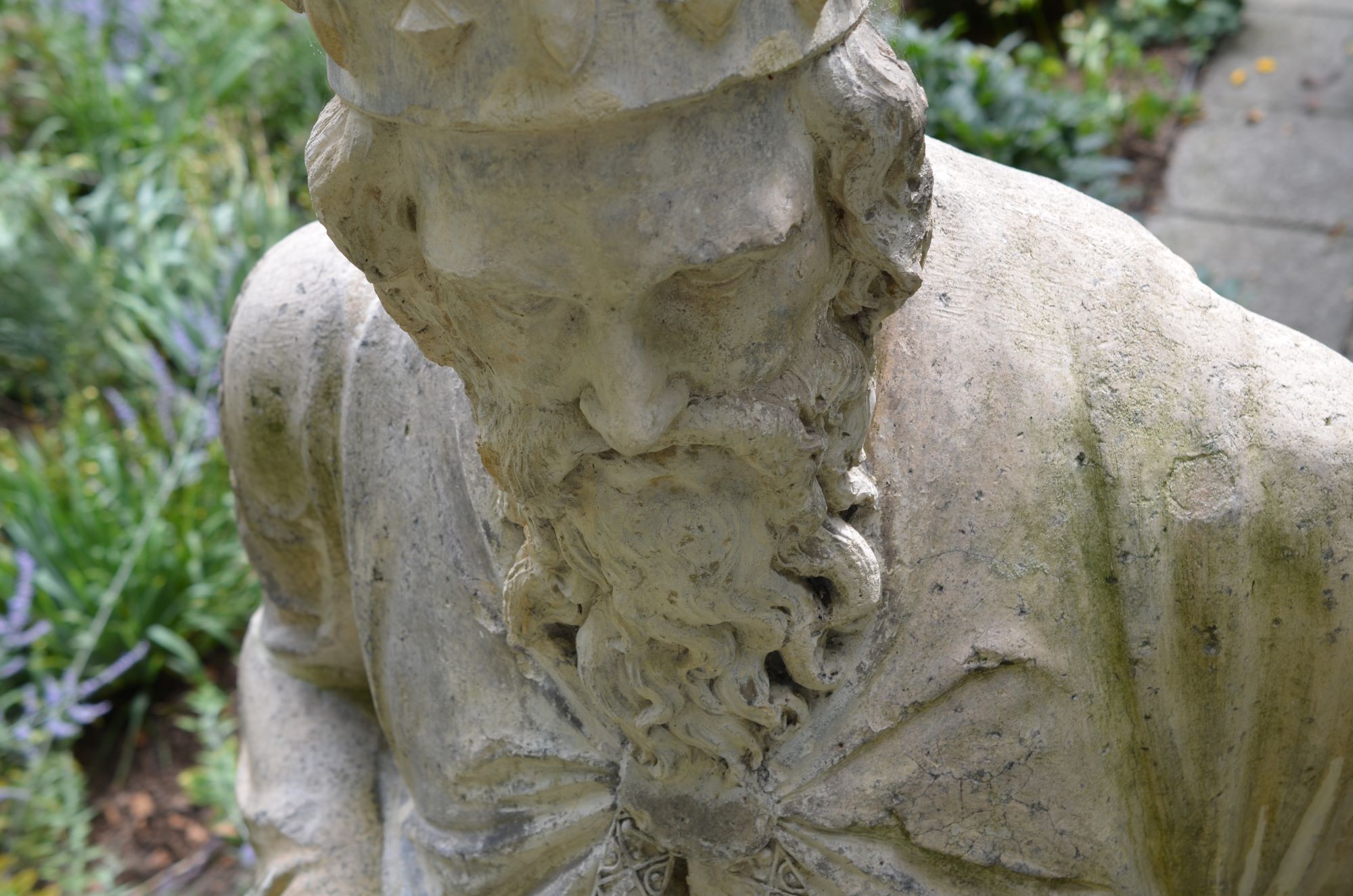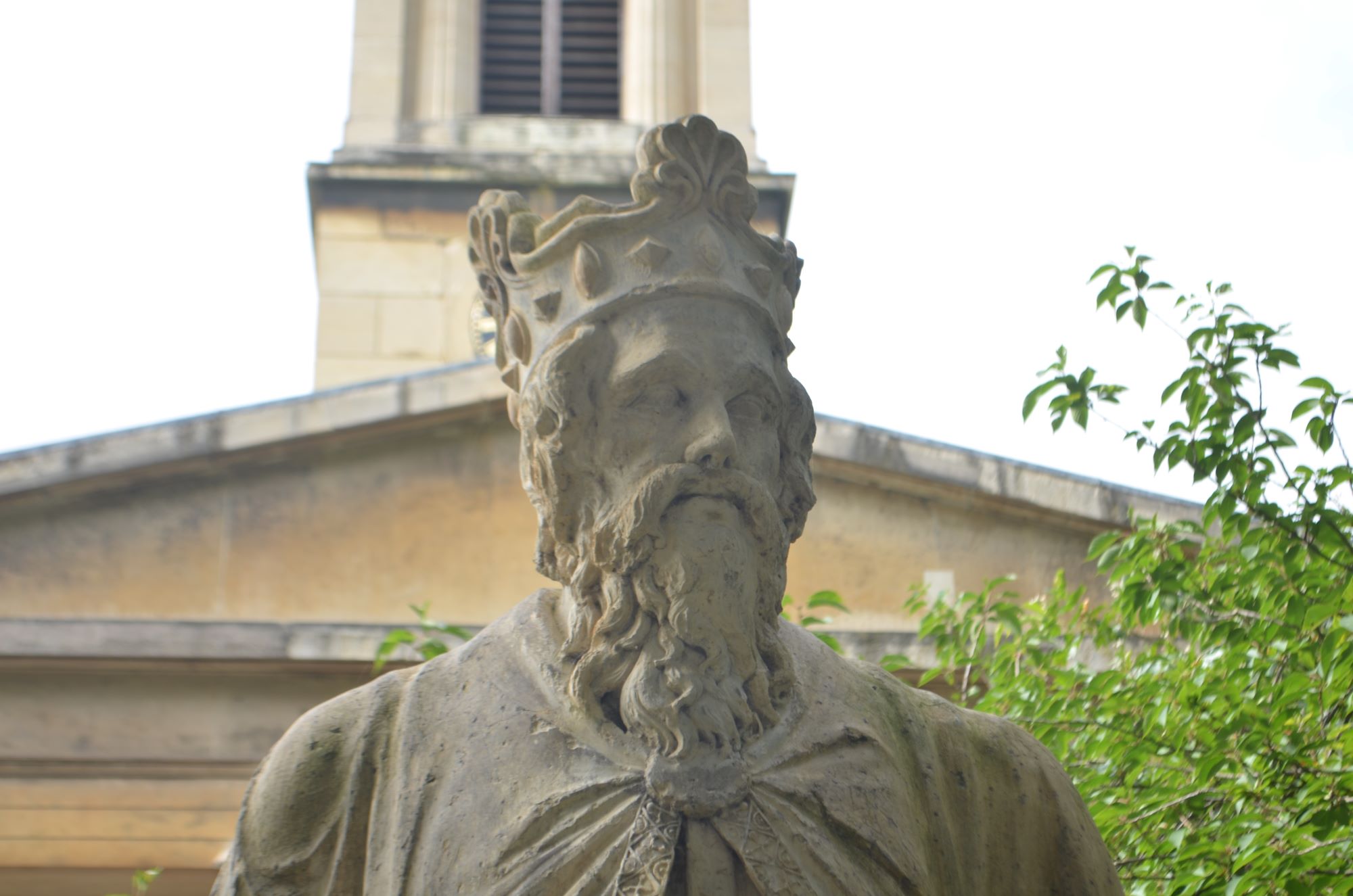The statue of King Alfred has stood in the garden of Trinity Church Square since before 1828. It was originally sculpted in the early 1820s by James George Bubb, who had a workshop off Tottenham Court Road. The statue has many intriguing features, not least a fragment of his right leg originating from a Roman sculpture.
Recently, AOC Archaeology created a 3D model of the statue, which you can explore below. The information about the statue and its historical background were kindly provided by Chris Constable, Borough Archaeologist, London Borough of Southwark.

Trinity House Corporation
Trinity Church Square forms part of the Trinity Estate in Newington, an area of the London Borough of Southwark centred around Elephant and Castle. The estate consists of Cole Street, Swan Street, Falmouth Road, Trinity Church Square and Merrick Square. In 1661, the estate was donated to the Trinity House Corporation by Christopher Merric.
Trinity House Corporation was founded by a royal charter of Henry VIII to regulate river pilots on the Thames. The duties of the Corporation were expanded under Elizabeth I to include the provision of beacons, marks, and signs for the sea to enable danger to be avoided. Today, the organisation is the official authority for lighthouses in England, Wales, the Channel Islands, and Gibraltar.
Trinity Church Square
Construction of housing within the Trinity Estate started in the 1810s with the establishment of Trinity Street. The church wardens of Newington Parish contacted the Corporation in 1820 to obtain a site for an additional church in the parish and were given the plot of the current Trinity Church.
In 1823, William Chadwick, a local builder, signed a lease for the development of the land to the south of Trinity Street, including the completion of the housing around the church. The lease included a provision to maintain the garden square as a turf plot or shrubbery for 70 years on a peppercorn rent. It is likely that William Chadwick was responsible for installing the statue of King Alfred during the 1820s.

An excerpt from the Ordnance Survey first edition 25 inch to the mile map, surveyed in 1872 and published in 1879. Map reproduced with the permission of the National Library of Scotland – view the full map here.
Who was King Alfred?
King Alfred, also known as Alfred the Great, was King of Wessex from 871 to 899 AD. He is perhaps most famous for his years spent resisting the Viking invasions and his part in the conversion of Viking leader Guthrum to Christianity.
In 886 AD, Alfred reoccupied the old Roman city of London and set out to restore it to a habitable trading town. He had a reputation as a wise, merciful, and learned king and during his reign put great emphasis on justice and education.
Roman Origins
Standing at 2.5m tall, the statue of King Alfred is an intriguing mix of Roman and 19th century sculpture. The statue’s robust right leg (from just below the knee up to Alfred’s belt) is carved from a shelly oolitic South Cotswold Limestone, a stone utilised by most Roman sculptures in London. The Roman part of the statue originally formed part of a sculpture of the goddess Minerva, dating to the early to mid-2nd century.
The statue’s pose, with the projecting right leg, has parallels with other Minerva statues, and the gathers of material between the legs indicates the original sculpture was wearing a tubular dress hanging from both shoulders. The Minerva statue probably stood to 3m high, and the inclusion of this Roman fragment has caused the odd proportions of the King Alfred Statue.




Creating King Alfred
The King Alfred statue is built using Coade stone, a fired ceramic product made from ball clay, a grog of pre-fired clay, ground flint, sand, and soda, lime and silica glass. The moulding and production of a Coade sculpture is a skilful task as the material shrinks by one twelfth in size during the firing process.
To make a sculpture from Coade stone, the sculptor would create a full-scale clay model, which was covered by a plaster mould. The plaster mould was then cut into pieces and the Coade mixture pressed in. After drying, the Coade was fired, then the separate pieces of the sculpture were assembled and the joints grouted.
Depending on the scale of a Coade sculpture, an internal structure may have been required to provide support. In the case of King Alfred, the Roman leg acted as the support for the Coade elements to be attached. The neat and continuous joins between the Coade elements and the Roman fragment are a testament to Bubb’s skill at managing the shrinkage of the Coade.
James George Bubb
The King Alfred statue was designed by the sculptor James George Bubb, who was born in 1782 and died in poverty in 1853. His main period of sculptural activity was between 1810 and 1830 when he had a workshop off Tottenham Court Road. Bubb’s most notable surviving work in London is the tympanum of Cumberland Terrace in Regent’s Park.
explore the 3D model⚬
explore the 3D model⚬
explore the 3D model⚬
explore the 3D model⚬
explore the 3D model⚬
Manchester’s King Alfred
Records held by Manchester Archives show that King Alfred was originally designed for Manchester Town Hall and produced between December 1823 and 30th June 1824, when Bubb asked for payment. Discussions with the architect of the Town Hall over the summer of 1824 led to concerns that the sculpture was too large for its niche at the front of the hall. Bubb agreed to produce a smaller statue and requested to exhibit the larger version.
The original Manchester Town Hall was demolished in 1912, but its façade with the second, smaller, sculpture of King Alfred was reassembled in Heaton Park, Manchester (see image below). The smaller statue includes all the same detail as the Trinity Church Square King Alfred, including the oversized right leg.





